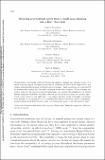Modeling gravitational waves from a small mass plunging into a Kerr black hole
Author(s)
Taracchini, Andrea; Buonanno, Alessandra; Khanna, Gaurav; Hughes, Scott A
Download9789813226609_0212.pdf (390.7Kb)
Terms of use
Metadata
Show full item recordAbstract
Copyright © 2018 by the Editors.All rights reserved. Gravitational waveforms radiated during the inspiral, plunge and merger stages of a small body moving in the equatorial plane of a Kerr black hole can be exploited to get unique, physical information on the strong-field regime. Such waveforms are constructed by numerically solving the Teukolsky equation in the time domain. When building the source term for the gravitational perturbations, one models the dissipation of orbital energy using the Teukolsky frequency-domain gravitational-wave flux for circular, equatorial orbits, down to the light-ring. The merger features of the Teukolsky waveforms have proven to be instrumental to extending the effective-one-body model of spinning, nonprecessing black-hole binaries, from the comparable-mass to the test-particle limit.
Date issued
2017Department
Massachusetts Institute of Technology. Department of Physics; MIT Kavli Institute for Astrophysics and Space ResearchJournal
The Fourteenth Marcel Grossmann Meeting
Publisher
World Scientific Pub Co Pte Lt
Citation
Taracchini, Andrea, Alessandra Buonanno, Gaurav Khanna, and Scott A. Hughes. “Modeling Gravitational Waves from a Small Mass Plunging into a Kerr Black Hole.” The Fourteenth Marcel Grossmann Meeting (November 16, 2017). doi:10.1142/9789813226609_0212.
Version: Final published version
ISBN
978-981-322-659-3
978-981-322-660-9
Collections
The following license files are associated with this item: